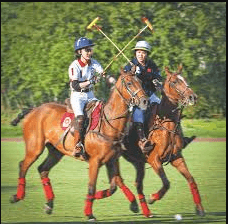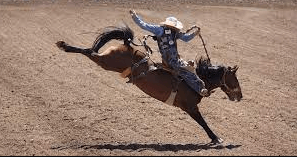What Are The Roles Of Players In A Polo Match?

In the vast expanse of a polo field, where the vibrant green grass stretches out to meet the horizon, a symphony of thundering hooves and clashing mallets echoes through the air. It is within this exhilarating arena that players embrace their roles with unwavering determination and skill.
Like chess pieces strategically positioned on a board, each player contributes to the overall symphony of teamwork and strategy, ensuring an enthralling display of horsemanship and athleticism. As we delve into the captivating world of polo, we will explore the distinct roles played by each player in this noble sport.
With its origins rooted in ancient Persia, polo has evolved into a modern-day spectacle that captivates both participants and spectators alike. The number one player, often referred to as the forward or offensive player, assumes a role akin to that of an artist painting bold strokes across a canvas.
Mounted upon their magnificent steeds, these players possess an unparalleled mastery over their horses as they gallop towards victory. Their primary objective is to score goals by maneuvering past opponents with finesse and precision while maintaining control over their horse’s speed and direction.
By embodying gracefulness in motion and employing strategic plays, these players become instrumental in driving their team towards triumph amidst the rhythmic chaos of battle.
The Role of the Number One Player (Forward) in a Polo Match
The role of the number one player, also known as the forward, in a polo match is essential for offensive strategies and scoring goals.
As the first player in the lineup, their primary responsibility is to lead the team’s attack and create goal-scoring opportunities. The number one player must possess exceptional horsemanship skills and a deep understanding of the game.
Their ability to control and maneuver their horse effectively allows them to navigate through tight spaces and outmaneuver opponents. Furthermore, experienced number one players bring immense benefits to the team.
Their knowledge of offensive tactics enables them to make quick decisions on where to position themselves on the field, creating openings for teammates and increasing the chances of scoring goals. Additionally, their expertise in reading plays and anticipating movements gives them an edge in intercepting passes or disrupting opposing teams’ strategies.
In summary, the role of the number one player is crucial for a polo team’s success as they contribute significantly to offensive strategies and play a pivotal role in achieving victory on the field.
The Role of the Number Two Player (Pivot) in a Polo Match
Pivoting participant plays a pivotal part in the proceedings of a polo game. Their role is crucial for the team’s success and involves strategic positioning and defensive support.
Here are four key aspects of the number two player’s role in a polo match:
- Strategic Positioning: The number two player, also known as the pivot, strategically positions themselves on the field to support both offensive and defensive maneuvers. They must have excellent field awareness and adaptability to read the game and anticipate their teammate’s movements. By positioning themselves in strategic areas, such as near the halfway line or close to opponents’ goal, they can effectively contribute to their team’s attacking plays.
- Defensive Support: One of the primary responsibilities of the number two player is providing defensive support to their teammates. They act as a bridge between defense and offense, helping their team regain possession of the ball while maintaining proper defensive formation. The pivot needs to be agile and quick-thinking, reacting swiftly to counter any threats from opposing players.
- Communication: Effective communication is essential for successful teamwork in polo matches, and it falls within the responsibilities of both forwards (number one players) and pivots (number two players). As a pivot, clear communication with teammates is crucial for coordinating strategies, indicating position adjustments, or signaling potential dangers during gameplay.
- Team Coordination: The number two player acts as an integral part of overall team coordination. They need to synchronize their efforts with other players by creating space for passes or working together during set plays like penalty shots or knock-ins. This coordination ensures that every member of the team maximizes their strengths while minimizing weaknesses.
Understanding these roles helps create a well-rounded team dynamic where each player contributes uniquely towards achieving victory on the polo field.
The Role of the Number Three Player in a Polo Match
Strategically positioned as the linchpin of the team, the number three player’s contributions on the polo field demonstrate their indispensable role in creating a seamless and powerful unit.
The importance of communication and teamwork in the role of the number three player cannot be overstated. As a central figure in the game, they serve as a link between offense and defense, coordinating plays and ensuring smooth transitions.
Read also: What Are The Risks Of Bull Riding?
Effective communication with teammates is crucial for successful strategies and swift execution. Additionally, the number three player possesses exceptional ball control skills, allowing them to maneuver through tight spaces and maintain possession under pressure.
Their strategic positioning enables them to support both offensive attacks and defensive maneuvers, effectively adapting their playstyle according to the game’s demands.
Overall, the number three player’s ability to foster teamwork, communicate effectively, and exhibit exceptional ball control makes them an essential asset to any polo team.
Frequently Asked Questions
What is the difference between a polo match and other equestrian sports?
A polo match is a unique equestrian sport that sets itself apart from other equestrian sports. It distinguishes itself through its fast-paced nature, the use of mallets to hit a ball, and the participation of four players on each team.
How are polo teams organized and how many players are there in a team?
In polo, teams are typically organized into two or four players per team. Each player is assigned a specific position, such as the number one, two, three, or back position. The organization of the team allows for strategic gameplay and effective coordination among players.
Are there any specific rules or regulations that players need to follow during a polo match?
Specific rules, regulations, and guidelines govern players in a polo match. These include restrictions on contact between players, the use of the mallet, and the positioning of players during set plays such as line-outs and penalties.
What is the role of the referee in a polo match and how do they ensure fair play?
The role of the referee in a polo match is to ensure fair play and uphold the rules. Through meticulous observation and decision-making, they maintain order on the field, ensuring that players adhere to the regulations for an equitable competition.
Are there any strategies or tactics that players use during a polo match to gain an advantage over their opponents?
Strategies and tactics play a crucial role in gaining an advantage over opponents in a polo match. Players employ various techniques, such as positioning, teamwork, and ball control, to outmaneuver and outscore their adversaries.
Conclusion
In a polo match, each player has a specific role and position that contributes to the overall strategy of the game.
The number one player, also known as the forward, is responsible for scoring goals and leading offensive plays. They must possess excellent horsemanship skills and have a strong sense of timing to execute precise shots.
The number two player, or pivot, plays a crucial role in both offense and defense. They are responsible for creating opportunities for their team by providing accurate passes to their teammates while also defending against opposing players. The pivot must have exceptional coordination and be able to quickly change direction on their horse.
Lastly, the number three player serves as a link between offense and defense. They are often referred to as the ‘quarterback’of the team because they control the pace of the game and make strategic decisions based on the flow of play. The number three player must possess strong communication skills and be able to read the game effectively.
In conclusion, each player in a polo match has an important role that contributes to their team’s success. Whether it is scoring goals as a forward, creating opportunities as a pivot, or controlling gameplay as a number three player, each position requires specific skills and knowledge.
As an old adage goes, ‘There is no ‘I’ in team,’highlighting the importance of teamwork in achieving victory on the polo field. By working together cohesively and fulfilling their respective roles, players can maximize their chances of winning matches.



